Introduction to the AMA Cub
The AMA Cub was designed by Academy of Model Aeronautics (AMA) technical director Frank Ehling in 1968 to be a simple, quick, reliable and inexpensive introduction to the hobby of model aviation. Since then, millions of them have been produced and used by schools, model airplane clubs, church groups, scout groups, recreation programs, senior groups and individuals. It is so simple and inexpensive that it invites experimentation and variation. Many variations have been published. It can be flown indoors in a school gymnasium and it can be flown outdoors in schoolyards, parks and ball fields. It can be flown as a hand launched glider, tow launched glider, high start glider, ROG (rise off ground) with wheels or as a kite.
See the AMA Cub Links page on this site for more background information.
Simple though it is, it still must meet all the requirements for flight. It may be used to teach all the elements of aviation. In my over two dozen years of teaching the AMA Cub, my goal has been that every kid who builds one will have success on the first flight. This illustrated tutorial will show you how to build an AMA Cub so it will fly well right off the building board. There is no need to tinker or fix it if correct trim is built-in during construction. I do a few things slightly differently than the instructions that come with the kit. The AMA Cub was the first in a series of increasingly complex models we used in our class. Each was used to teach skills necessary to move on to the next level. We had regular contests, so skills leading to high level performance were encouraged from the start.
This tutorial shows the building and flying of the AMA Cub from the kit manufactured by Sig and sold by the AMA. The Delta Dart manufactured by Midwest products, and other variations on the AMA Cub, are built in much the same way, but may require minor adjustments. This tutorial may seem long and detailed. It is. When I started teaching the AMA Cub, I was surprised to find out how much I had to tell the kids. I didn’t know I knew so much! Many small steps are required to build and fly an AMA Cub, but each of them is essentially easy, anyone can do them. One of the most important things kids can learn from building an AMA Cub is that wonderful things result from many small, simple steps; from a simple model airplane to a career in aviation.
Building an AMA Cub
The first thing we do is open the kit and examine the parts. Study the plan and figure out where all the parts go. If you are teaching a class, it is important that you have successfully built and flown an AMA Cub before teaching the class. You must be familiar with each step before you teach it. Showing the students a completed Cub makes it much easier for them to visualize and understand how all the parts fit together. You can point out and name all the parts and how they fit together. It also gives you the opportunity to evaluate the appropriateness of different materials and methods in relation to your students and resources. There are often several ways to do each step. I have used different ones myself. The pictures show how I built this particular airplane. I will note alternatives, where appropriate.
The instructions tell you that, in addition to the materials provided in the kit, you will need glue, a single edge razor blade, tape, pins and a flat building board.
Different kinds of glue can be used. Any glue that will stick wood to wood and paper is fine. Everything can be done with the standard cellulose glue for wood model airplanes. Experts dilute the glue slightly with acetone and put it in special bottles with a narrow spout, so the glue may be applied in small amounts and will soak into the wood. This glue dries faster than water based glue, but it is not as tacky and parts must be held together until the glue has dried. Acetone may be used to soften the glue if something must be disassembled. I like to use a water solvent glue because it doesn’t stink and washes off of hands, tables and clothes. I like Titebond, Elmers or similar carpenters wood glue because they are tacky and hold things together better before they dry. In this tutorial, I have used Titebond for the wood and Elmers for the paper. (I have a whole row of different glue bottles along the back of my work table.) The glue can be softened with water if parts must be separated, but water also affects the paper. Some use glue stick to stick the wood parts to the paper, but stronger glue must be used for the wood-to-wood joints. In a building session with many students and limited time, we have used cyanoacrylate “instant glue” (CA) with a little baking soda to form fillets and make the dihedral joints between the wing and stick. We don’t let the kids use CA glue, trained mentors make those glue joints. Aeromodelers learn to use the minimum amount of glue necessary to make a strong joint. Excess glue adds weight and weight is detrimental to flight. Excess glue also takes longer to dry.
The single edge razor blade has a metal backing bent around the back edge to protect your fingers from cuts. Lou tells the kids this is a “danger blade” because it can cut you badly if used carelessly. Never touch the sharp cutting edge. Don’t wrap your fingers around the sharp edge when you pick it up or hold it. Pick it up from the back. Never cut toward any part of your body. The blade can slip and go where not expected. Don’t put it down on the edge of the table where it can get knocked into your lap.
The tape will be used to tape the covering paper to the building board.
Pins are often used to pin the strips of balsa wood to the board. I find that it is not always necessary to pin most of the AMA Cub wood parts to the plan. It is preferable to not weaken the thin wood parts with pin holes. Don’t put pins through the thin wood parts. Pin clamps may be used to hold parts to the board. The one exception might be the fuselage stick, which can get knocked around. One pin is used to make the rear motor hook. Pins are sharp and can make painful punctures. Put them back in their container to prevent them wandering off and poking somebody.
The building boards are three layers of corrugated cardboard, with the grain running the long direction in the outer two layers and crosswise in the inner layer. This makes a fairly stiff board that will stay flat through many building sessions. I cut them 12″ x 18″ so they can also be used for making the other planes we taught in our class, with plans printed on 11″ x 17″ sheets. See the post Make a Building Board for details.
Something not mentioned in the instructions is a cutting board. If the students cut the wood parts against the building board, the boards will soon be shredded. (If you are building over a plan on one of the other planes, the plan will be cut to shreds, too. You may want to use the plan to build another plane.) Small scraps of stiff cardboard, wood blocks or plywood, 2″ x 3″ or so, should be used as a backing to cut the wood. You don’t want them cutting on the table top, either.
I also use small scraps of thin cardboard to spread the glue thinly onto the wood where it contacts the paper. I cut a bunch 1/2″ x 3/4″ from a cereal box.
Toothpicks are handy for putting glue onto the ends of the sticks or into corners for the wood-to-wood joints. Plastic bottle caps are a handy place to put a large blob of glue.
You also see a file, wire cutter and round nose pliers in the picture. I recommend that you not use the single straight pin for the rear motor hook as shown in the instructions. The motor knots will rub on the stick and slow the propeller revolution rate. I make a proper hook that keeps the motor from rubbing on the stick. It is up to the teacher to decide whether the students are able to form the wire part, or whether the teacher will need to make or buy a sufficient supply of them before class. They can be bought from several dealers online, but they are easy to make.
Here are the contents of the kit. There is an instruction sheet, printed covering paper, tapered 1/8″ x 3/8″ x 12″ balsa motor stick, ten 1/16″ x 1/8″ x 9″ balsa sticks, a propeller assembly that includes propeller, shaft and bearing, an 18″ long, more or less, 1/8″ wide rubber strip motor and the bag it all came in. (You can get bundles of parts, which you must sort into kits, at less cost.)
Strength and balance are important considerations in building airplanes. Balsa wood varies in density and strength. It is preferable to put the heavier wood near the front of the plane to meet the balance requirement and the stiffer wood where greater strength is needed. To do that, we must sort the sticks. It happens that the stiffer sticks are also the heavier sticks. (Lighter wood is also usually lighter in color.) You can sort them by weight, if you have a sensitive balance. It is easier to sort them by stiffness, especially if you have many students. The easiest way to sort by stiffness is to gently, slightly bend the sticks in your fingers.
Bend them just enough to feel how stiff they are. Be careful not to break them. You may have to go through the pile a couple times to make the comparisons.
A more precise measure can be made using a kitchen or postal scale. If you press down on the end of a long column, it will resist up to a certain pressure, then it will buckle. Once it buckles, it will continue to bend without offering further resistance, until it breaks. This is known as the Euler buckling test, after Leonhard Euler. In a large class, use of the scale is impractical, unless you have enough to go around.
Sort them into three piles; stiff, medium and soft. With the scale, you can sort them into five piles. The stiffest sticks go in the wing leading edges. The softest sticks go in the fin and in the tail leading edges. The offcuts from the tail leading edges become the wing ribs. The medium sticks go everywhere else. The tail trailing edge should be a medium stick because it is long and must be stiff.
The AMA Cub differs from most model airplane kits in that the plan is printed on the covering material and the sticks are glued directly to the covering material.
Tape the paper to the building board face down. The sticks will be glued to the back of the paper. The paper is thin enough that you can see the ink from the back. (It is possible to make the AMA Cub without taping the paper to a building board. Cut out the paper pieces and glue the sticks to the paper pieces on a tabletop.)
The motor stick is glued to the paper only in the area marked XXXX under the fin. To separate the fin paper from the adjacent paper on the motor stick, use the razor to cut the line A-A. Only a light cut is necessary here, just enough to go through the paper.
Next we glue the motor stick to the paper. It is important that the taper be on the underside of the stick. A common mistake is to put the tapered edge on top, next to the fin. You can start by placing the stick on the plan, carefully aligning it within the ink lines. Now turn the stick over to expose the surface that was in contact with the paper, which is where the glue must go. Apply glue to the part of the stick that was in contact with the XXXX marked area of the paper.
Spread the glue with a small scrap of thin cardboard. The wood should have a uniform, thin coating of glue. There should be enough glue to be shiny, but thin enough to see wood through it.
Turn the stick over, align it very carefully within the ink lines and press it down onto the paper. Check that the tailplane taper is in the right place, at the back end, underneath, opposite the fin. Hold it firmly with one hand while pressing it down with the other.
This stick may be pinned to the paper to prevent it being knocked loose while working on the other assemblies. Push the pins in at opposing angles near each end to hold the stick down. If the pins are parallel, the stick can rise up on the pins.
The small sticks that make the edges of the flight surfaces must be cut at angles on their ends. It is easier to see where to make the cuts if you extend the lines beyond the drawing with a straightedge and pencil. Otherwise the line is invisible under the stick. (It would have been easier to do this before gluing the motor stick down.)
Similarly mark the wingtip and tail corners.
Mark the centerline at the wing leading and trailing edges. Also mark the centerline of the tail at its apex.
Wood-to-wood glue joints will be stronger and lighter if the mating surfaces are flat and square, with no gaps. This first piece will be the lightest stick and it will be the trailing edge of the fin. I use a sanding jig to square the end of the stick. This is a block of wood with a stick glued across one surface at a right angle to an edge.
The squared end is placed snugly against the motor stick between the lines of the drawing. The razor blade is placed directly over the pencil line marking the end of the stick and the blade is pushed into the wood just enough to make a mark.
The stick is cut against a firm, flat backing. In this case I am using a small block of wood. The stick is held firmly with a finger, close to the location of the cut for good control. The blade is aligned with the cut mark, with the blade vertical, and it is pressed down with a finger against the back of the backing strip. A rocking or sawing motion may be used. Very hard wood may require several cuts be made with the corner of the blade, drawing the corner across the cut mark.
I put a blob of wood glue into a plastic milk bottle cap. Cover the cap with a block of wood when not in use, to prevent the glue from drying out.
I spread a thin line of paper glue along the surface that will be in contact with the paper. It is a good idea to place the stick on the paper first to make sure you are putting glue on the right surface. Some builders dilute the white glue with an equal volume of water and paint the glue onto the stick with a 1/8″ wide brush. The water might warp these thin sticks, but they straighten when the glue dries. If you use dilute glue, you will want to use pin clamps to keep the sticks down flat on the paper as they dry. Some prefer stick glue. I find that stick glue does not give as good coverage, leaves lumps of glue on the edges of the stick and kids often break sticks while rubbing the glue onto the wood. If you want to use glue stick, tell the kids to put the stick on the table, hold the stick down at one end while drawing the glue stick away from the finger holding the stick down. Turn the stick around to get glue on the other end.
Spread the glue thinly with the card squeegee, as on the motor stick. Remove any excess glue.
Dip the squared end of the stick into the wood glue.
Place the square end of the fin post snugly against the top of motor stick, lining it up carefully with the end, between the printed lines. Press it down against the paper. Be careful to not bend it, as it will unbend later and wrinkle the paper. This is especially important with the longer sticks.
Fins get knocked off easily. Apply a little wood glue all around the joint with a toothpick to form a glue fillet. Put a little dab into the inside of the corner.
If you want, pin clamps can be used to hold the balsa to the paper. Pin clamps maybe purchased online. They also may be made from plastic can lids, using a leather punch or paper punch. Punch out little circular disks and push a pin through the center of each. There is enough friction between the pin and the disk that the disk will hold the sticks to the board. (You can also make pin clamps from 1/2″ lengths of balsa stick waste. Save the scraps from AMA Cub builds to make them.)
Place the remaining piece of stick over the fin leading edge on the plan to mark the angled cut with a dent from the razor blade where it will be glued to the stick. The other (top) end was already cut at the right angle when you cut off the stern post. Align that end with the top end of the fin leading edge on the drawing and mark the cutting line directly over the top edge of the motor stick.
The fin leading edge is glued in place in the same way as the trailing edge. Don’t forget to put a little glue fillet around the joint with the motor stick and inside the corner. The other surfaces are made in much the same way. No glue is used between the tops of the sticks. (Some people cut the sticks to extend all the way to the pointed tip and glue them together.)
Place one of the hardest sticks over the plan for one of the wing sticks and mark it for cutting close to one end. We cut parts from close to the end to conserve wood. The offcut may be used to make another part if it is left big enough.
Once the end is cut, place the stick back down on the drawing, align the first end carefully and mark the cut on the other end.
Use the first one as a pattern to cut three more, one from a hard stick and two from medium sticks. Keep the hard and medium sticks separate.
You can keep track of where they go by placing them on the drawing. The hard sticks go on the leading edges, which are at the top of this picture.
Pick up the sticks, turn them over, spread a thin layer of glue on the surface and press them to the paper. Do not join the wood parts to each other with glue.
You can press them to the paper by holding one end down with fingers and running another finger along the stick. Be careful to not bend the sticks laterally.
Glue down all four wing spars. You may hold them flat with pin clamps. Put the pins through the paper outside the perimeter. The pins do not go through the wood.
Mark and cut the tip of a tail leading edge from one of the light sticks. This is where it is especially important to make the first cut close to the end of the stick, because the offcut will be used for a wing rib.
Mark and cut the tail leading edge stick on the centerline. You can use this stick as a pattern to make the opposite stick. (Some cut the first stick off along the outer edge of the opposite side and cut the second stick to fit.)
The first leading edge is glued and pinned down, the second tail leading edge is cut out and has paper glue spread on its underside and the inside end is dipped in wood glue. (Note that the offcuts have been placed on the wing near where they will go.)
Place the ends snugly together in the center and press the second tail leading edge down onto the paper.
Place a small bit of glue across the cut and inside the corner to form a strengthening fillet. The tail trailing edge is cut from some medium density wood and glued to the paper in the same way.
The offcuts from the tail leading edges are cut to make the two wing ribs. Glue them in place, using wood glue between the wood parts.
Press them down onto the paper.
Cut out the center wing rib from a medium hard stick. Place it over the plan. Each end requires two cuts to form a point, to match the shape shown on the plan. We tell the kids to cut it to look like the roof on a house. It fits snugly between the leading and trailing edges. (You can make an adjustable wing by cutting the leading and trailing edges about 1/16″ short on the inside ends, leaving a 1/8″ gap between them at the center, and cutting the center wing rib long enough to extend about 3/16″ beyond the leading and trailing edges. The wing dihedral joints must be glued up separately from the motor stick, with the central rib held flat to the board and the tips raised equally on each side. A short taper is sanded on top at each end of the central rib. The rib is strapped to the motor stick with dental elastics, so it can be slid back and forth for trim adjustments.)
Gently press the first end in place, mark and cut the other end. It should be a snug, light friction fit.
Apply glue to the underside only and press it in place. Do not glue the wood to wood. These joints must remain flexible so we can form the dihedral joint later.
Give the glue time to dry. You can do something else while waiting for the glue to dry, like make the motor hook or tie the rubber motor knot. The glue on the fin will have dried first. You can start pulling the pins out of the fin first. Hold the wood down adjacent to the pin when you pull the pin out. When you pull a pin out, immediately put it back in the container. Don’t let pins wander away where they can poke someone. (You, most likely.)
Start by cutting from the leading corner of the fin to the line A-A. Use the corner of the blade, point down, with the flat blade against the flat side of the stick to guide it. This cut is made with light pressure, just enough to cut through the thin paper. Be careful to not cut into the wood.
Cut the paper along the leading edge of the fin, starting at the motor stick. Always cut around the outside of the part. Light force is applied downwards. The blade is run along the stick using it as a guide. It is not necessary to apply any force to the stick. Avoid cutting into the stick by keeping the blade parallel with the face of the stick.
Cut all the way past the corner of the ink triangle. Do not cut the little paper triangle off the tip. It will be folded and glued around the ends of the sticks to strengthen the joint.
Cut along below the motor stick from the A-A line to the back end of the stick.
Cut the paper along the trailing edge of the fin, continuing out a little past the corner of the ink triangle.
Lift the motor stick and fin from the board. If there is paper overhanging the taper, remove it with a sanding block. The taper must be flat to receive the tailplane.
Apply paper glue to the small triangle at the tip of the fin. Spread it with a scrap of card.
Wrap the paper triangle around the end of the fin tip and press it in place.
In a similar way, remove any pins and cut the paper around the perimeter of the wing and tail.
We have now cut out all the main subassemblies of the AMA Cub.
Apply glue to the small paper triangles at the wingtips and tail tips, and fold them over, as was done for the tip of the fin.
Cut a 1/8″ square block from one of the hard pieces of scrap wood.
Use a toothpick or scrap stick to apply a square of wood glue to the back end of the tailplane taper under the motor stick.
Put the square block on the end of the motor stick, wiggle it around a little to get glue all over it, then press it squarely in place. Set it aside where it won’t get bumped so the glue can dry. This shim adjusts the tail angle to give better flights. The angle between the wing and tail is called decalage. Numerous glide tests were made to establish the decalage that permitted minimum sinking speed.
We are going to glue the top surface of the tail to the underside of the motor stick. This puts paper between the wood. The paper is actually somewhat soft and will come apart if stressed. To overcome this weakness, we use a pin to poke many small holes through the paper at the apex of the tailplane. This is more of a problem with cellulose glue than water glue, because it soaks into the paper less than the water glue.
Also poke many small holes in a small square in the center of the trailing edge.
Cut a crutch from scrap wood to fit between the apex and center of the trailing edge of the tail. Cut the front end in a roof shape like the ends of the center wing rib.
Cut the back end off square. It should be cut to be a sliding friction fit. The purpose of this crutch is to keep the paper taught while the fin is glued to the motor stick. If the tail paper is loose, it can flop around and spoil your flights.
Press the crutch into place. It should be snug friction fit, without distorting the framework. A light touch with a sanding block may be helpful to get an exact fit. Do not glue it in place. It will be taken out later.
Apply glue to the center of the tail trailing edge. Work glue into the pinholes in the paper.
Apply glue to the apex in the same way.
Block the motor stick in place so it is perpendicular to the table, centered on the tail and is in uniform contact with the apex and trailing edge of the tail. Let the glue dry. You can tell about when the glue is dry by putting a blob of it on a piece of plastic and watching it. At first it will be opaque, but when it is completely dry, it will be translucent. (Cellulose glue will smell when it is still wet.) You might want to apply a little glue fillet in the corners of the glue joints, for added strength. If you are in a hurry, you can do something else while waiting for the glue to dry, like make the motor hook, tie the motor knot or scrape the propeller to balance it.
When the glue is quite dry, you can slide the crutch aside and remove it from the tailplane.
You can push a pin into the stick as it says on the plan. Be careful that it is centered and goes in centered, so it doesn’t go out the side and stick your finger. Keep your fingers out of the line of the pin. I do this only to prepare a hole for a round motor hook.
Cut the head off a pin. Hold the shaft and cover the head so nothing shoots off when the cut is made. (Some use paperclip wire to make the hook. You can buy finished hooks from online suppliers.)
The cut will leave a sharp chisel point that will poke your finger and cut the rubber motor. File the cut end round.
Use the round nose pliers to make a right handed helical loop in the end of the pin. If you don’t have round nose pliers, a nail may be used. The loop should be about 1/8″ in diameter, more or less. Make a fist with your right hand and stick the thumb straight out. A right hand loop goes forward in the direction the thumb points when going around the loop in the direction the fingers point.
It is a complete loop with a slight overlap at the end. This helps keep the lubricated motor from twisting off the end of the hook.
Its helical form leaves an opening into which the motor may be threaded. The right hand helix discourages the twisted motor from twisting off the end.
Bend a 45 degree angle a little ways from the loop to form a riser that spaces the loop up from the stick and a base that lies along the stick.
Bend the pointed end back 45 degrees. Because the end is short and sharp and hard to grip, use a block of wood to make the bend. Start the bend against the face of the pliers with a right angle. Avoid a very sharp bend that might break the wire. I have filed a 1/16″ diameter quarter circle into the edge of the pliers to permit this gradual bend. You can also make this bend against a small nail.
Push the wire out a little from the face of the pliers to finish the bend back to match the angle of the pin hole that went into the motor stick..
The finished motor hook, ready to install.
Put some glue in the hole and on the tip of the pin and insert the pin into the hole.
Press it snugly against the stick and make sure it is flat against the wood.
Spread glue around and over the part of the wire that is in contact with the wood. Neil recommends wrapping and gluing thread around the stick and the wire.
Making the Motor
Now we make the motor. The kit contains a strip of rubber 1/8″ wide and from 17″ to 19″ long. We make a rubber band by tying the ends together. Since we are teaching best practice and we will be using a lubricant on the motor, we must use a knot that will not slip when lubricated. A square knot will not hold. Unexpectedly, a reverse double overhand knot does hold. Wash and dry the rubber strip before making the motor. To tie knots in rubber strip without fraying or nicking it, it must be lightly lubricated. (Some use saliva. I find that doesn’t work well.) If you use full strength lube, you will be able to watch a knot untie itself. The straight lubricant is made by mixing equal parts of liquid green soap and glycerin. Both may be obtained at a pharmacy. I have also used Johnson’s baby shampoo or Joy liquid dish soap and glycerin. The soap makes it slippery and the glycerin keeps it moist. For knot tying, I dilute the lube with an equal part of water. Dip the end two or three inches of both ends of the strip in the knot lube.
Dip both forefingers into the lube and spread it around on the thumbs. (I wash my hands before making the motor. Dirt is an enemy of a tightly wound motor.)
Put the two ends together.
Tie a simple overhand knot in the doubled strand.
Pull the two sides of the loop apart to move the knot toward the ends.
Pull until the knot is about 1/8″ from the ends.
Pull the knot tight. (Recently I have found that a wood clothespin is a good way to grip the short ends while pulling the knot tight.)
Dip the end in the knot lube again and tie another overhand knot behind the first one, but this time looping around in the opposite direction.
Pull this knot up tight against the first one. Again, pull the ends to tighten both knots.
Final Assembly
Slide the propeller hanger onto the front end of the motor stick. The hook at the end of the prop shaft should be under the stick, in line with the rear motor hook at the back.
Put the end of the motor opposite the knot into the propeller hook. If it doesn’t go in easily, stretch it to make it thinner.
Put the knotted end of the motor onto the rear motor hook.
Loop a piece of dark thread around the motor stick and suspend it to find the balance point. Move it back and forth until it hangs with the stick level.
Hold the thread in place and mark its location on the left side of the stick at the top.
Measure to the midpoint of the center rib and mark that location on the left side of the rib.
Push two pins into the center rib, about 1/2″ from the ends, angled about 45 degrees seen from the side and perpendicular to the surface seen from the ends.
Apply wood glue to a 1/2″ length at each end of the center rib. A spot of glue in the center is OK, but it is not necessary to have glue along the entire length of the rib.
Carefully align the center rib with the top of the motor stick and align the pencil marks with each other. (I put the wing center mark 0.1″ ~ 3/32″ ahead of the motor stick mark. That’s where my glide tests said to put it, but I don’t think it makes much difference.)
Push the pins into the motor stick. Double check that the center rib is flat against the motor stick, aligned with the motor stick and the pencil marks are close together. Establishing the wing position in this way assures that the plane will be properly balanced for flight. If the wing is placed as shown on the plan, the center of lift will be ahead of the center of gravity, making the nose rise and the plane will stall. It will be necessary to add clay weight at the nose to bring the center of gravity under the center of lift. Weight is the enemy of flight, especially if you are going to compete in a timed contest for duration of flight.
Turn the airplane upside down over the board, resting on the tips of the fin and one prop blade, and pin the wingtips to the board. Don’t bend the wing spars when you do this. The pins can go in the corner of the wingtips, between the sticks and through two layers of paper.
Adjust the fin position until it is perpendicular to the board and, more importantly, the tail is parallel with the board. If the tail is tilted relative to the wing, you will have an unintended turn in flight. It is best to avoid that until you understand it and do it deliberately.
Put a pin on either side of the fin tip to hold it in place.
Apply wood glue between the ends of the wing spars and the center rib. Use a pointed toothpick to get glue all the way to the bottom of the gap. This is a weak point in the design of the AMA Cub. These joints have open gaps between the wood parts being glued. This is one place where lots of glue is required. (Some cut thin wedges from the ends of the hard sticks to fill these gaps. Get glue all over the joint before pushing the wedges in place.) Get glue all over the end of the stick, the side of the center rib and the motor stick where they come together. Apply glue to all four sticks where they join the center rib. (If you have several students and you are in a hurry, you can use CA. Only adults should use CA. Use a small, flat stick or No. 11 Xacto blade to deposit and form a fillet of baking soda in the joint. Drip a drop of CA onto the baking soda. The baking soda acts as both a filler and a catalyst. A CA joint can not be soaked apart with water or acetone. A broken joint must be repaired with CA.)
Get glue along the edges of the spars and the top of the motor stick. Get some in between the open ends of the wing sticks.
Get glue inside the corners between the wing sticks and the center rib. This heavy glue will take a long time to dry. Put a blob of glue on a piece of plastic and watch to see when it is dry. This is a good time for a little break. As soon as the glue dries, the airplane will be ready to fly. After the glue has dried, check the joints. If there are still openings, a second application of glue may be necessary to finish filling any holes. Be patient and wait for the glue to dry completely. It must be hard, or you will have a wing fold up during flight.
Once the glue is thoroughly dry, remove the pins from the wingtips and from either side of the fin. Hold the wingtip down as you withdraw the pin.
Remove the pins holding the wing to the motor stick.
Check that everything is square and true. The airplane is now ready to have a motor installed and go flying.
Put a small drop of light machine oil on the prop shaft, between the propeller and bearing. Sewing machine or model train oil work for this.
Flying the AMA Cub
We must prepare the motor for winding by coating it with a lubricant. The lubricant allows the strands and knots to slide over each other without tearing. It allows many more turns to be put into the motor. The classic lubricant is a mixture of one part liquid green soap and one part glycerin. The soap makes it slippery and the glycerin is a moisturizer. (Many fliers are using silicon lubricants. I have avoided these because I don’t know the medical consequences of getting inorganic silicon compounds on my hands.) Some put the lube in the palm of their hand and massage the motor between their hands. We put the lube in a plastic baggie. It is a little less messy. This lube washes of easily in water; it is soap.
Drop the motor into the bag.
Massage the motor inside the baggie.
Draw the motor out of the bag between fingers to remove excess lube. A paper towel, diaper or handkerchief is handy to wipe lube off your fingers. Twist and fold the motor to put it into a container if you are not ready to fly it. The motor must be protected from sunlight, dirt and dryness.
Prepare a turns table for the motor. Every motor will break at a certain number of turns. Turns to break is estimated using a formula. Percentages of breaking turns are written in a table. See my post Motor Turns Tables Formula for more information.
The turns table for a 9″ loop of 1/8″ rubber looks like this:
AMA Cub
9″ loop of 1/8″
103.8 tpi
% Turns
100 934
95 888
90 841
85 794
80 748
75 701
70 654
65 607
60 561
The turns table for a 12″ loop of 3/32″ rubber looks like this:
AMA Cub
12″ loop of 3/32″
119.9 tpi
% Turns
100 1438
95 1367
90 1295
85 1223
80 1151
75 1079
70 1007
65 935
60 863
Keep in mind that every batch of rubber has different properties. A turns table can be accurate for a particular batch of rubber and a particular winding protocol, but it can be only a rough guide for another batch. We generally avoid winding our motors beyond 75%, so they will last longer. That is already enough to hit the low ceiling in our gym. If you are flying competitively, you will use a longer, thinner motor. A longer, thinner motor will take more turns per inch, has more inches to take more turns, has lower torque so the propeller will turn more slowly, will climb more slowly without hitting the ceiling, will cruse longer and come down more slowly, providing a longer flight, providing it is thick enough to power the plane. A good choice from the standard widths would be a 12″ loop of 3/32″ rubber. This is made from a 24″ strand of rubber and weighs the same as the 18″ strip of 1/8″ wide rubber. A light Cub can be flown on an 18″ loop of 1/16″ strip. The kit motor can be finger wound. A longer motor is difficult to wind without a winder. A winder works best if there is an O-ring in the motor. To learn more about making up motors, see my post on Making a Rubber Motor. (If you are very competitive, you will have a stripper and cut the rubber to an exact width and length.)
Here are some of the other things I would take to the field to fly my AMA Cub. A roll of twine, baggie and ball are useful for recovering a treed Cub. Put the ball in the baggie and tie the end of the twine around the top of the baggie. Lay some twine out on the ground and throw the ball over the branch to shake the Cub down. Two containers with motors. It is good to have a backup motor in case the first one breaks. A camera with spare batteries if you want to get pictures of your flights. A baggie of lube to refresh the lube if it dries out. A towel to wipe lube off your fingers. A stopwatch to record flight times. I forgot to include the notebook for recording flights in the picture. The winder and foot stooge. A belt pack or lunch box is handy for carrying everything.
Every pilot must check the weather and terrain before making a flight. It is best to fly the Cub when there is little or no wind. You will need a place large enough for the Cub to circle without hitting obstacles. It can fly inside in still air within a basketball gym. Outside, the Cub’s flight circle will drift downwind. You can control where it goes by selecting your launch location, on the upwind side of the field, and the number of turns you put into the motor. You can control your cub’s flight to prevent it from being lost into tall trees, onto building roofs or into back yards. Visualize the flight trajectory and plan your flights to avoid obstacles.
To finger wind the motor, hold the motor stick close to the prop bearing with one hand and turn the prop in a clockwise direction, seen from the front, with the index finger of the other hand. If you turn it the wrong way, the freewheeler ramp on the front of the prop hub will allow the prop shaft to rotate without winding up the motor. Count out turns by tens like this: one, two, three, four, five, six, seven, eight, nine, ONE, one, two, three, four, five, six, seven, eight, nine, TWO, one, two, three, four, five, six, seven, eight, nine, THREE, one, two, three, four, five, six, seven, eight, nine, FOUR, one, two, three, four, five, six, seven, eight, nine, FIVE, one, two, three, four, five, six, seven, eight, nine, SIX, one, two, three, four, five, six, seven, eight, nine, SEVEN, one, two, three, four, five, six, seven, eight, nine, EIGHT, one, two, three, four, five, six, seven, eight, nine, NINE, one, two, three, four, five, six, seven, eight, nine, TEN… At this point you have ten tens, or a hundred turns. Keep going until you have counted to FORTY or FIFTY. That is four or five hundred turns. (You will quickly understand the advantages of having a 10:1 winder.) This is enough for a first test flight.
The purpose of the test flight is to check balance, trim and turn. Hold the motor stick under the center of the wing with your favored hand at shoulder height or just above your head. The wings should be level and the nose may be pointed slightly up. Hold one tip of the prop below the plane with your other hand. You can take a step forward as you release first the propeller then immediately the plane, with a gentle push. The motor and propeller have enough power to fly the plane.
The launch is to bring it just up to flying speed, it is not necessary to throw the plane. Throwing it hard will result in a nose up zoom, stall and a fall. If the airplane was built carefully according to the instructions, it should climb slightly, flying at a steady speed in a left turning circle. If the flight is successful, you can increase the number of turns for the next flight. Keep increasing turns until you feel the motor beginning to fight back. This will be at about 70-75% of breaking turns. You can make many flights at this number of turns before the motor may break. If the plane seems to be slowing after several windups, try freshening the lube. If that doesn’t help, the motor is fatigued and needs to rest over night, or it has got a serious nick and is about to break.
With the kit motor, about 400 to 500 turns will get flights of about 40 to 50 seconds. At around 600 turns the flights will drop down to around 30 seconds again because the rapidly increasing motor torque will make the plane bank and turn left enough that it will spiral down rather than climb. Over a smooth surface, the plane may even bounce on the floor a couple times before climbing.
To overcome this, bend the prop hanger a little to the right, as shown in Step 27 of the kit instructions. The right thrust will reduce the left turn under high torque.
If flying indoors, you still must plan your flight trajectory. First, the AMA Cub normally flies in a left hand circle. You must launch it so the launch position lies on a circle that fits within the room. Imagine a large circle with its center at the center of the room. You will be standing on that circle with your right shoulder near the center of a long wall and your left shoulder pointing to the center of the room. You will launch the AMA Cub straight forward, parallel with the wall. After your first flight, you will have a better understanding of fitting the flight circle within the room. Second, the AMA Cub with a fully wound motor will hit the ceiling of most gyms. Start with about 400 turns on the motor and judge how close it gets to the ceiling. Increase the number of turns by 100 until it gets close to the ceiling, then increase by 50 or 25. If it hits the ceiling, back off half way to the last count that did not hit the ceiling. Iterating by halves will get you as close as you dare to the ceiling. To get the longest flights, you must utilize as much of the available vertical space as possible. That means launching from as close to the floor as possible. Crouch down, holding the stick just behind the wing with one hand and the tip of the prop straight up in the other. Rock back, move forward and when the plane is up to flying speed, release first the prop, then immediately release the plane.
As you add more turns, your Cub will climb higher, circle more times and stay up longer. This is the joy of free flight. The highest flights will happen with the 9″ loop of 1/8″ rubber. The longest flights happen with the 18″ loop of 1/16″ rubber.
Always pick your AMA Cub up from the motor stick. It is the strongest part of the plane. Picking it up from a wing, tail or fin risks damaging it.
A longer motor will be difficult to hand wind.
The longer motor will hang down in a loop. It will not be aligned with the prop shaft.
If you attempt to hand wind this motor, it will wrap around the prop shaft and jam.
One way to wind this motor is to weave it through your fingers to take up the slack.
A better method is to use a foot stooge and a geared winder. This one is made from a small block of 3/4″ pine with a couple holes drilled through and a bit of coat hanger wire pushed through and formed into hooks that hold the propeller. This also allows you to stretch wind the motor. In stretch winding, you stretch the motor about 5 times its relaxed length. As you wind, you gradually reduce the amount of stretch so you get to the rear hook about the time you finish winding in the number of turns you want. Stretching allows you to put in more turns. More turns on the motor means more turns of the propeller means more time in the air.
You may count cranks of the winder handle by tens, too, but each count is multiplied by the winder ratio. For example, with the 10:1 winder shown, each count of ten turns of the handle is 100 turns on the motor, so a count of FIVE is 500 turns on the motor.
The propeller is held in the hooks, the rubber is looped into the winder hook, it is stretched and wound. Keep a firm grip on that block with your toe.
Winding may be done rapidly at first. Winding rubber puts energy into it and it becomes warm. Get a heavy rubber band. Touch it to your cheek and feel its temperature. Now stretch it and quickly touch it to your cheek. You will feel the heat. Hold the stretch until the rubber cools, then relax it suddenly. Quickly touch it to your cheek. The rubber will feel cold. Rubber is a heat engine. Heat increases the tension in the rubber. If you wind fast, the tension will increase rapidly until the rubber breaks, sooner than expected. The winding stretches the rubber, warming it. The more turns you put in, the greater is the torque, the more energy is put in with each successive turn and the more heat is generated. To get maximum turns, you must slow the winding speed as you approach maximum turns to let the motor cool and relax.
This stooge is made from just a bent piece of coathanger wire. It is two parallel legs of a long, narrow U, with the bottom bent over to form an L and the tops bent to form hooks. This one is easy to lose in the grass. It would be a good idea to paint it a high visibility color.
Be careful with any foot stooge, especially when stretching the rubber. If the stooge gets away from you when the rubber is stretched, you will launch it as from a slingshot. Keep it firmly in contact with solid ground with firm pressure from your foot.
If you have a friend with you, your friend can act as a stooge, holding the propeller and hanger firmly between thumb and finger, as seen in a photo above, as you stretch the motor out and wind it with a winder. This grip holds the hanger against the pull of the stretched motor and also blocks the prop from turning. When a friend is acting as your stooge, always ask “Are you ready?” and wait for the reply “Yes.” before stretching the rubber. If you pull when the stooge is not ready, the plane may slip out of his fingers and crash into you.
The basic AMA Cub is only the beginning. It may be used to illustrate basic principles of aeronautics, and much more.
You can add flight control surfaces made from bits of paper to demonstrate the action of ailerons, elevator and rudder.
It may be flown as a rise off ground (ROG) by adding landing gear.
It may be flown as a hand launched glider (HLG) by replacing the motor and prop assembly with a lump of clay on the nose.
It may be flown as a tow launched glider (TLG) or high start glider (HSG) by putting a tow pin under the motor stick and pulling it up on a string.
It may be flown as a kite by removing the motor and prop assembly and tying a kite line around the motor stick at the midpoint of the wing chord.
You must look closely to see the kite string in this photo.

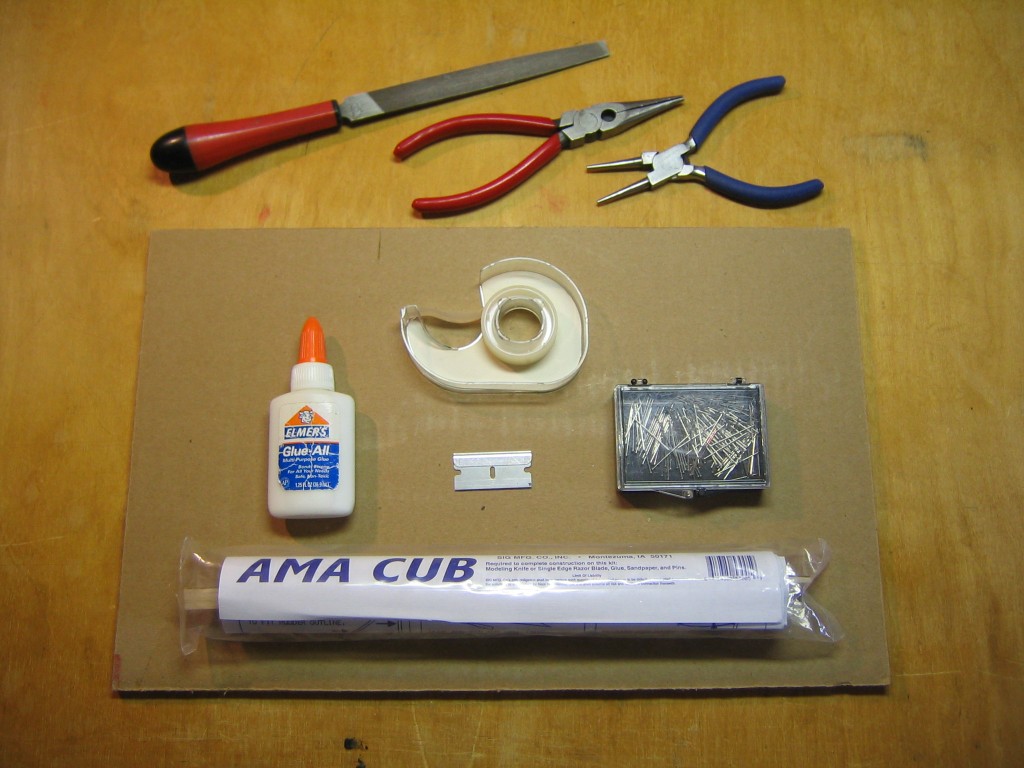

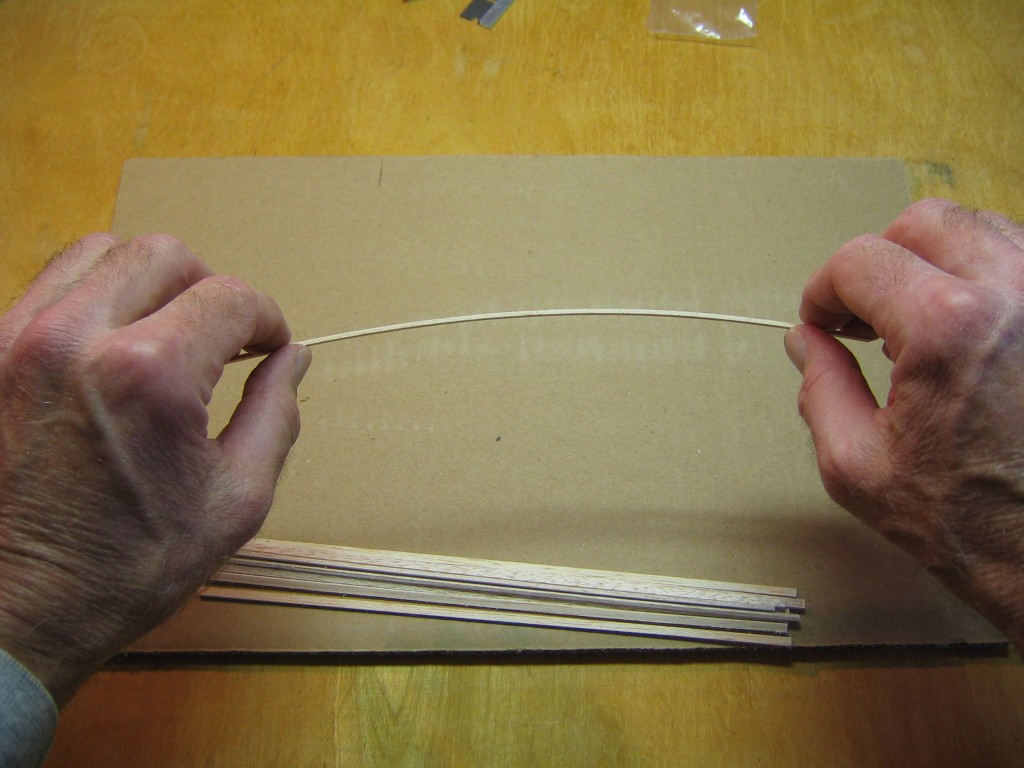
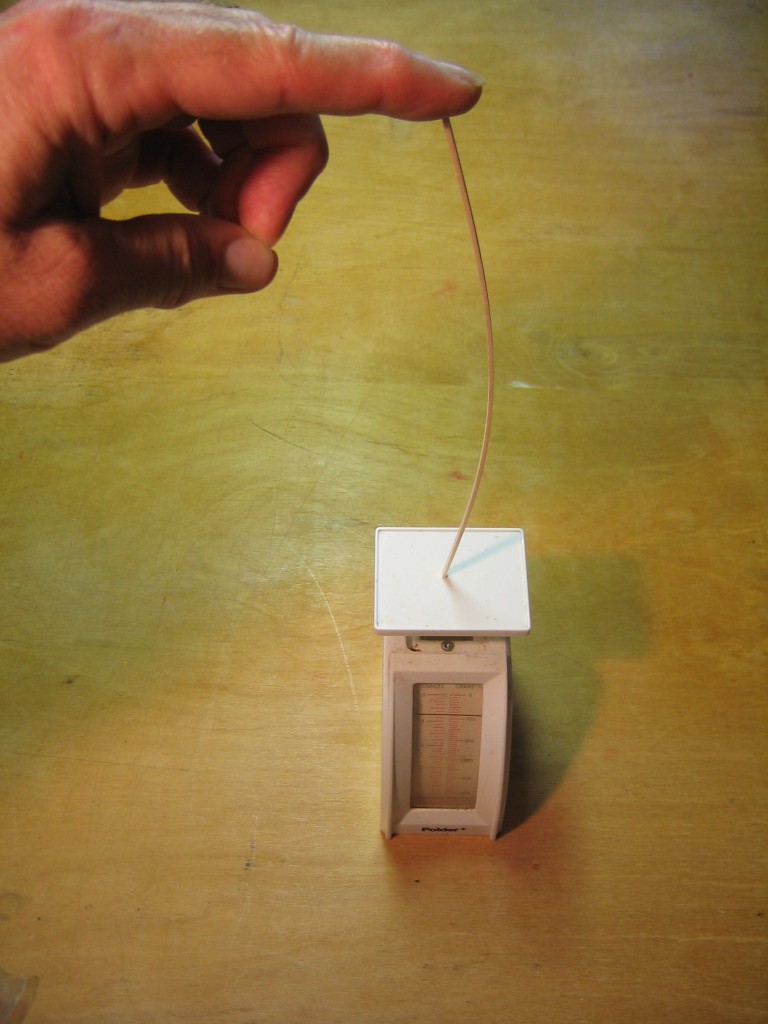





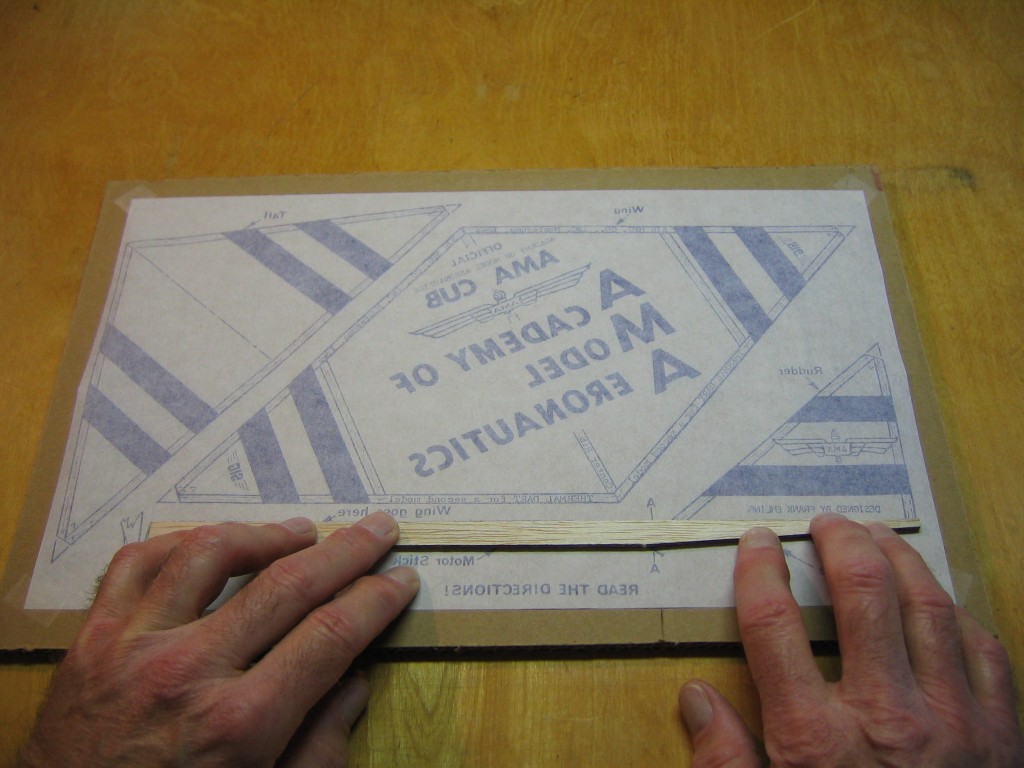












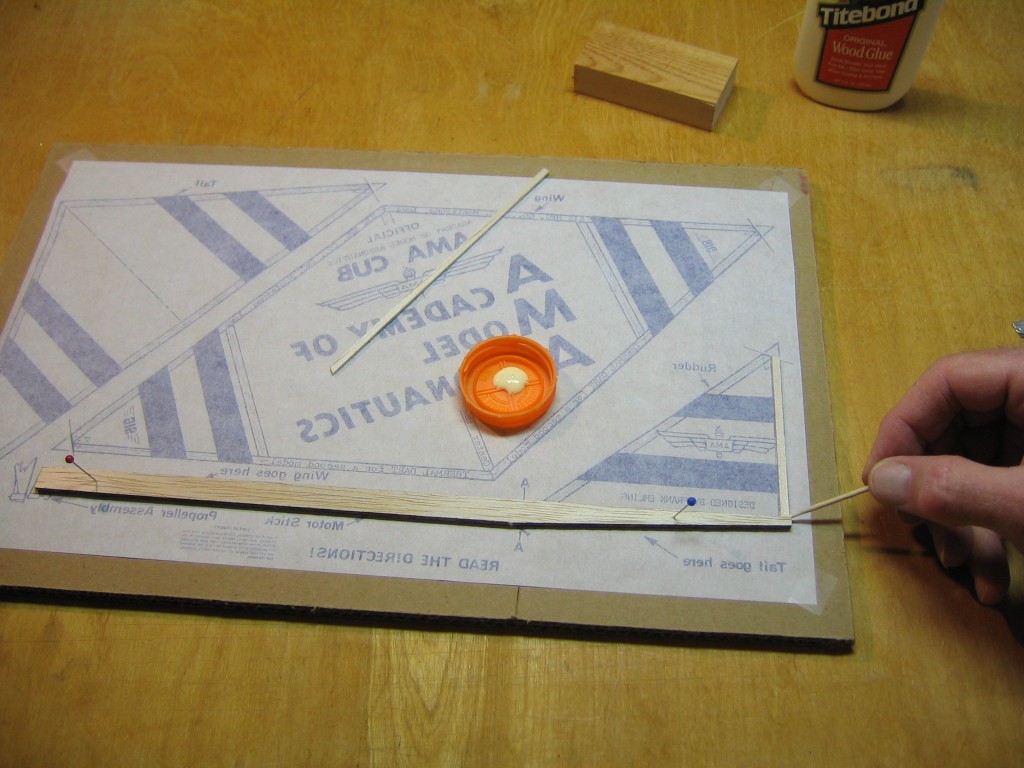


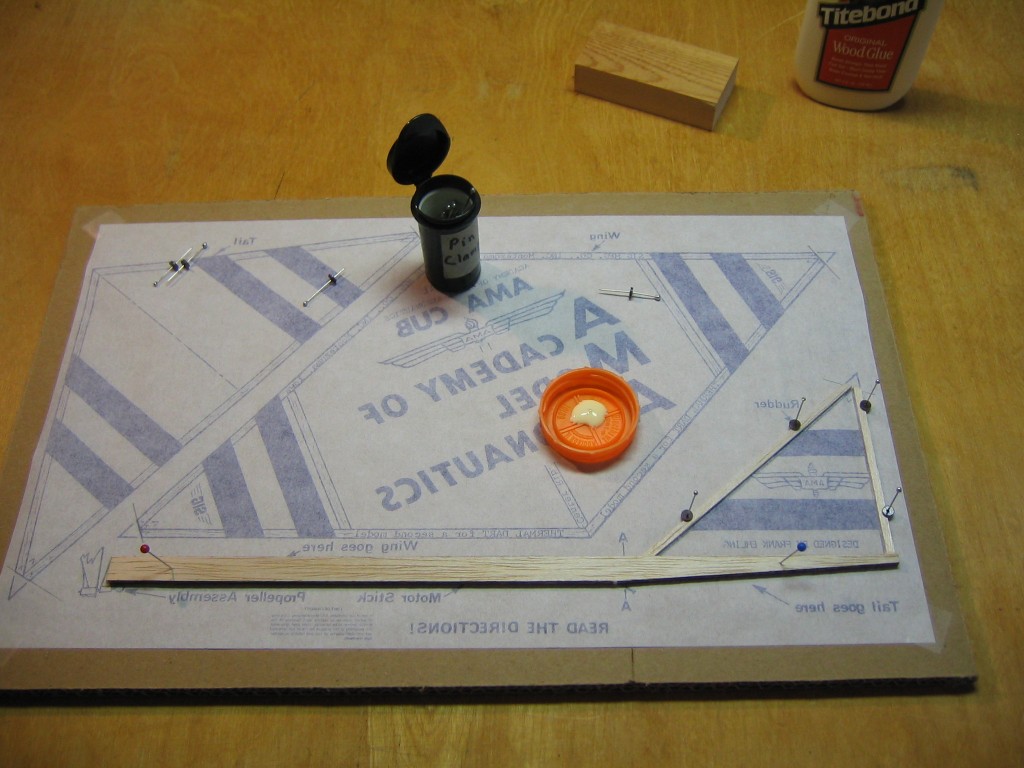





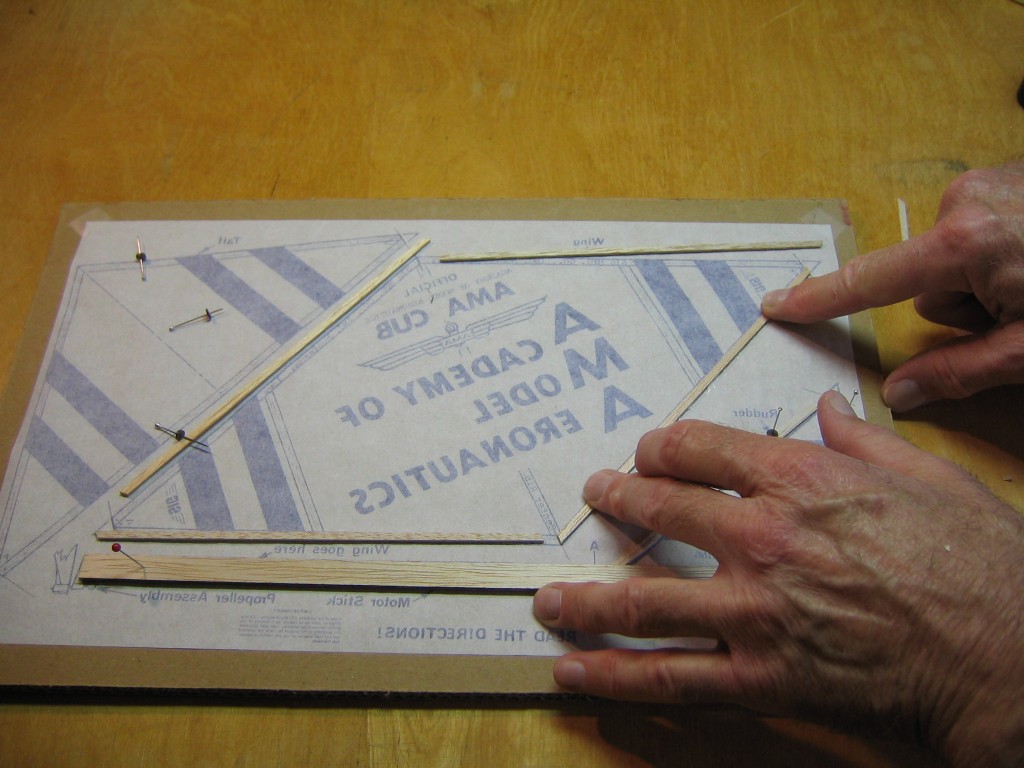

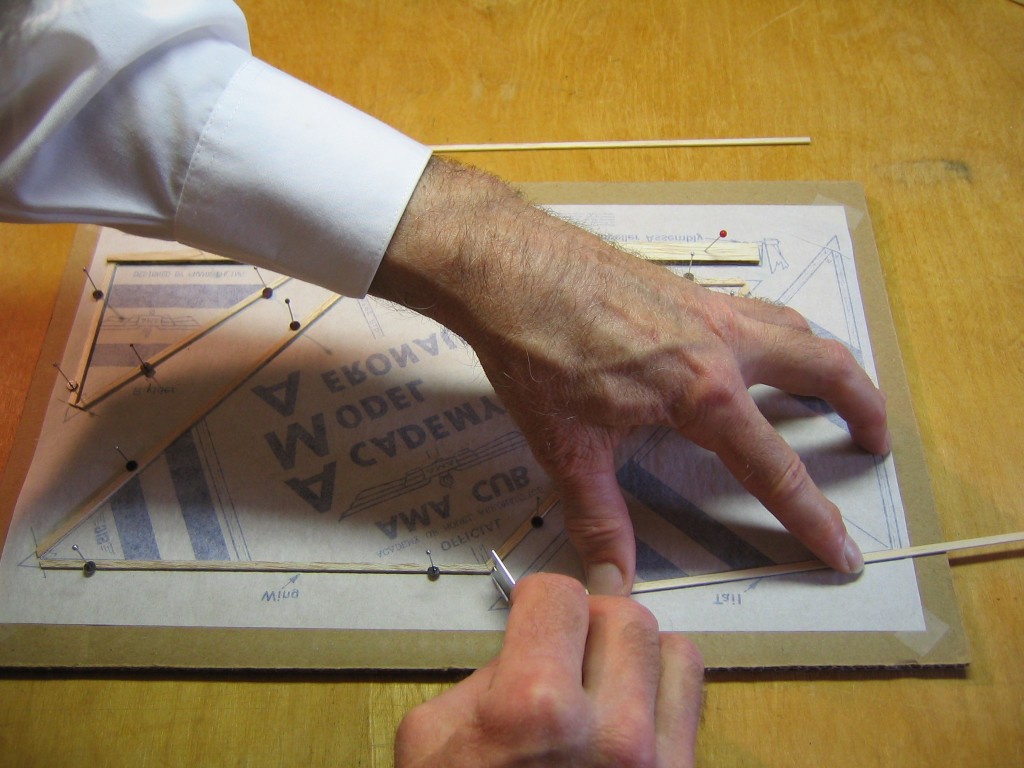




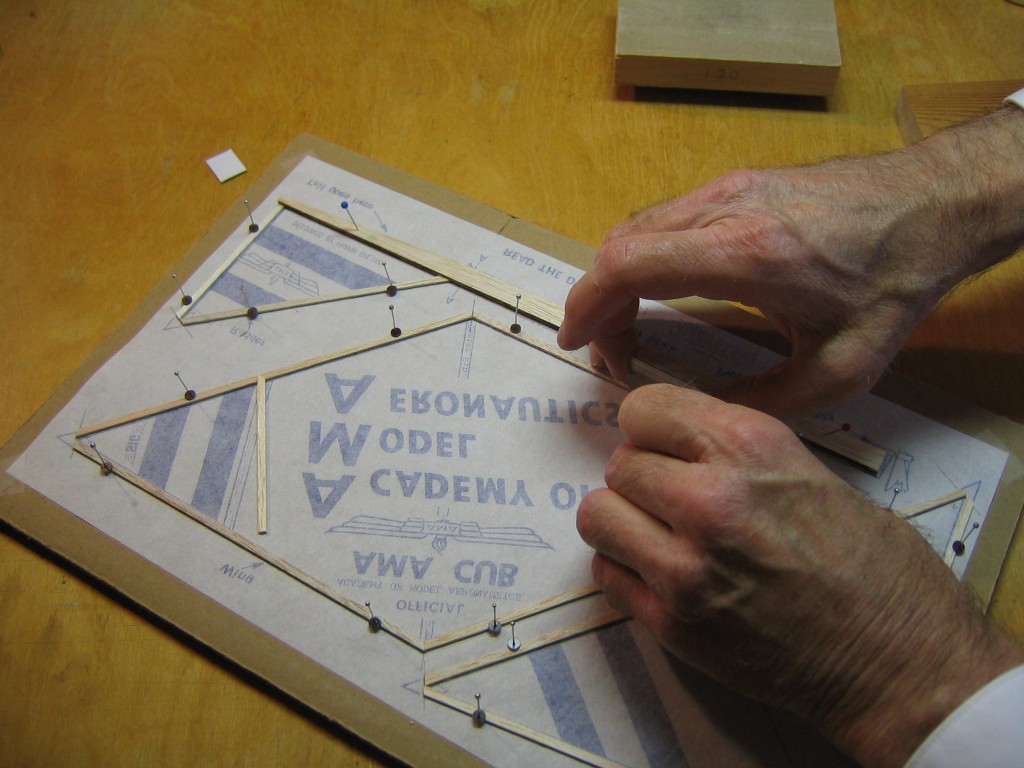
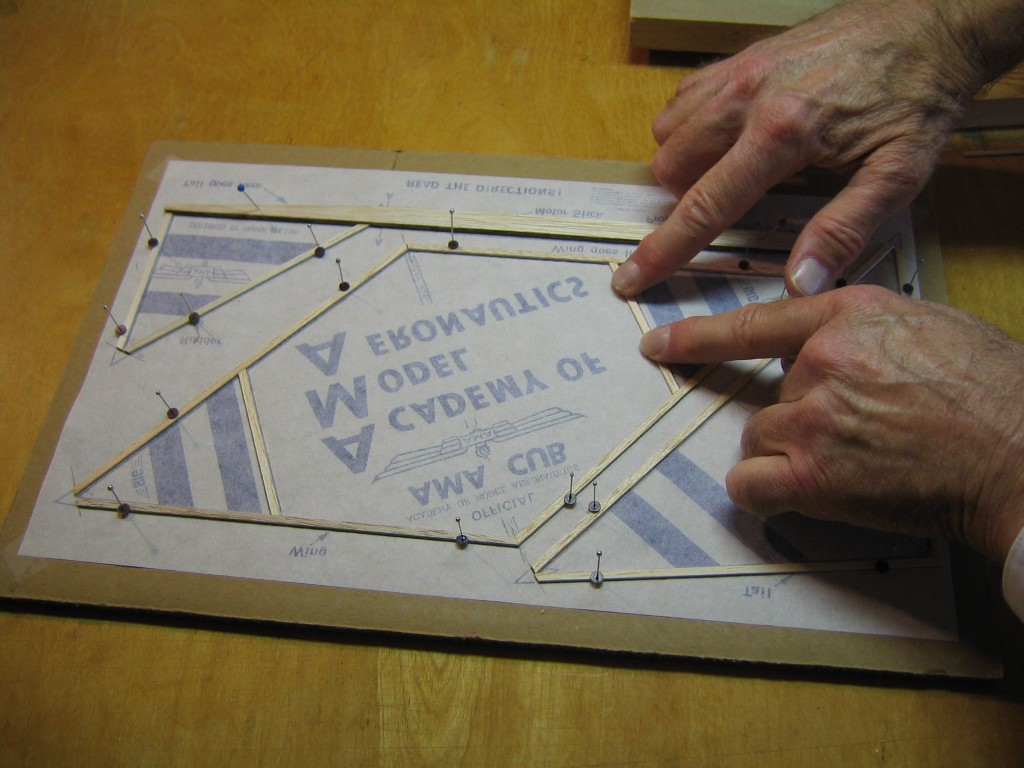






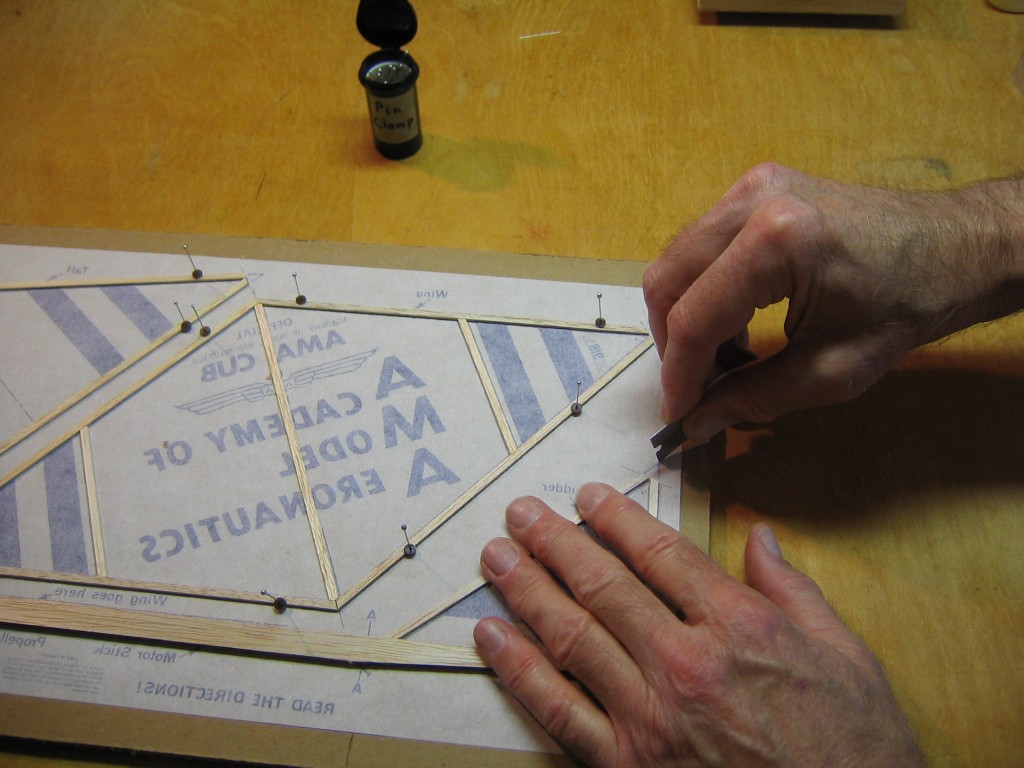










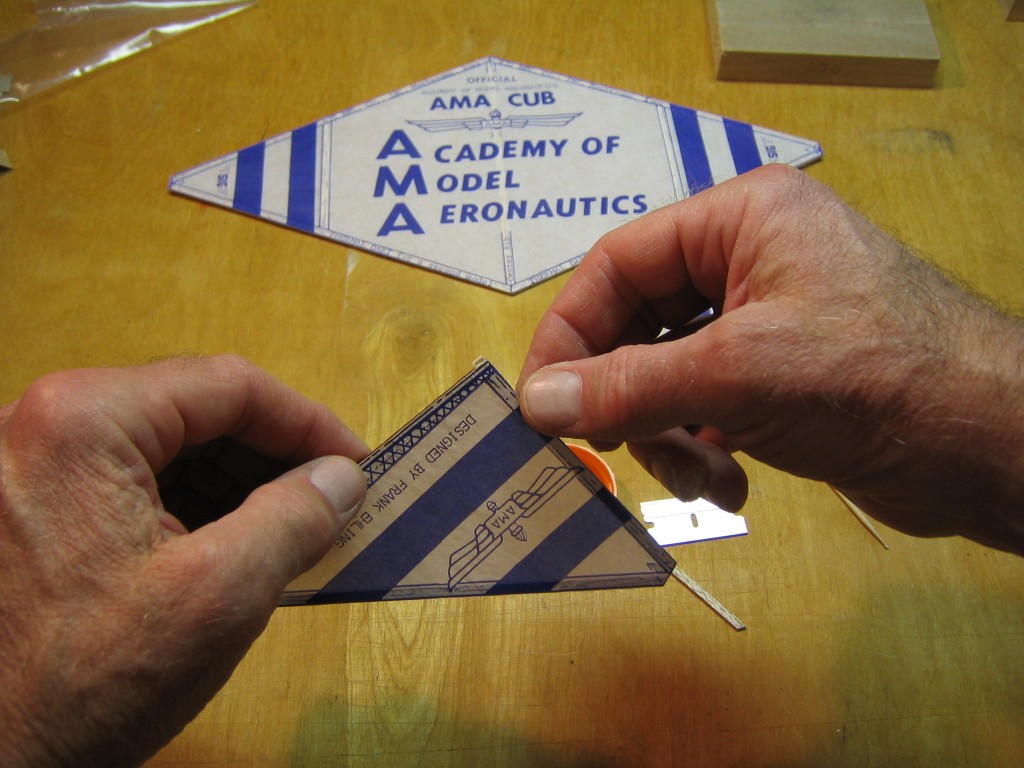
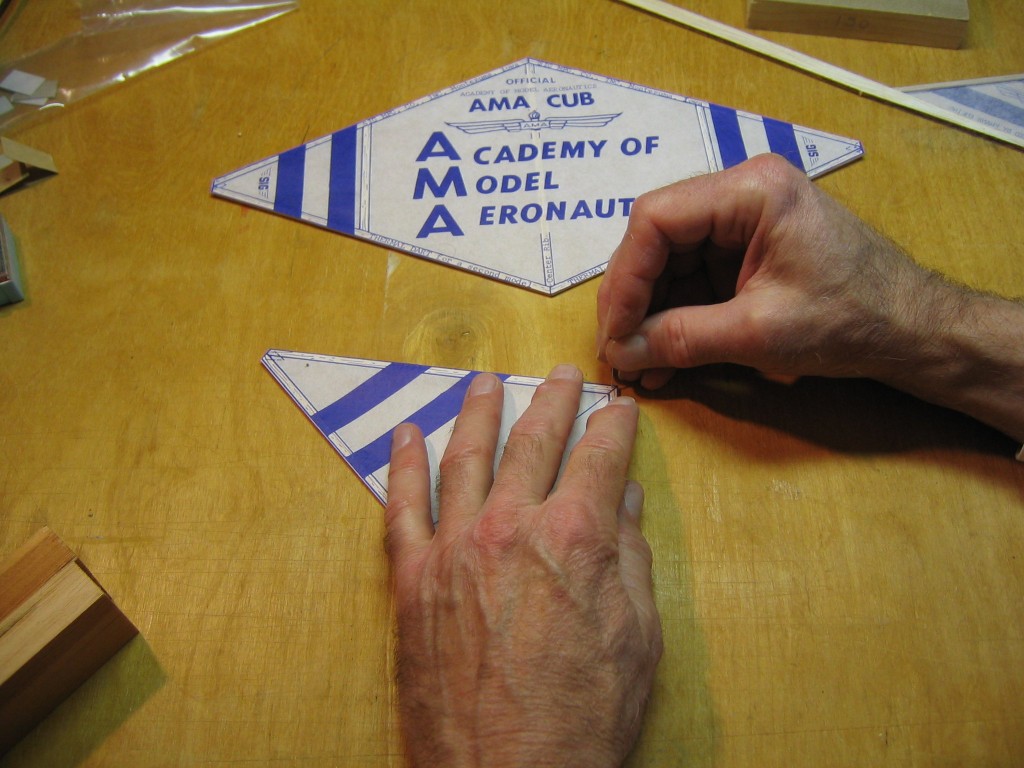





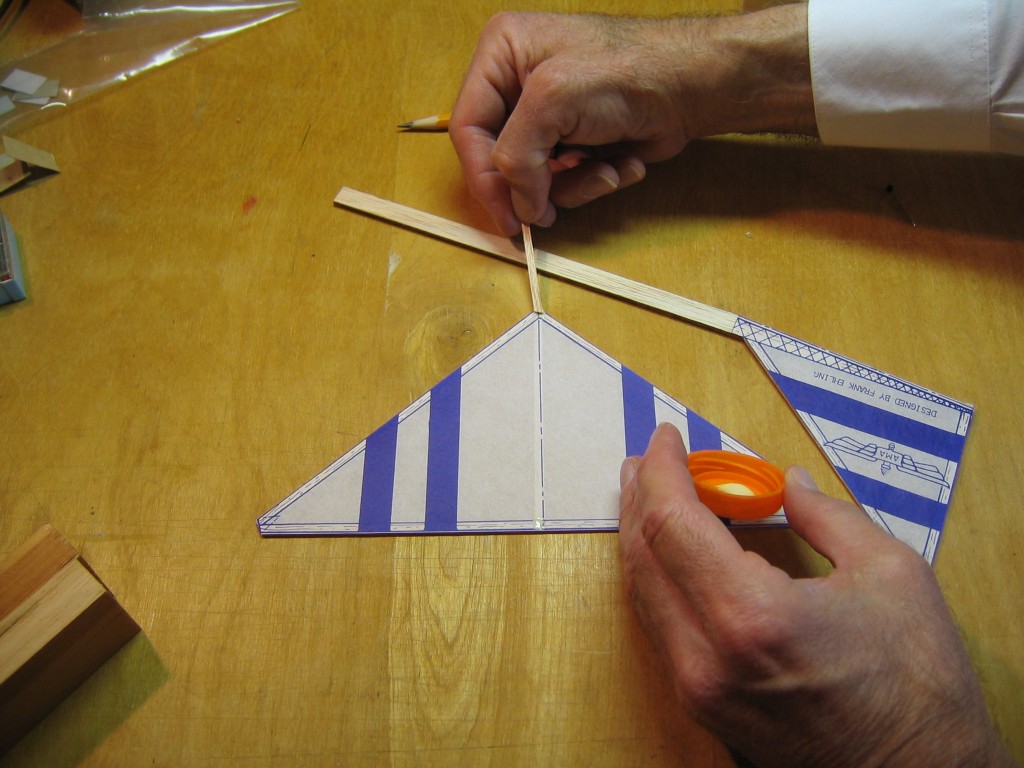





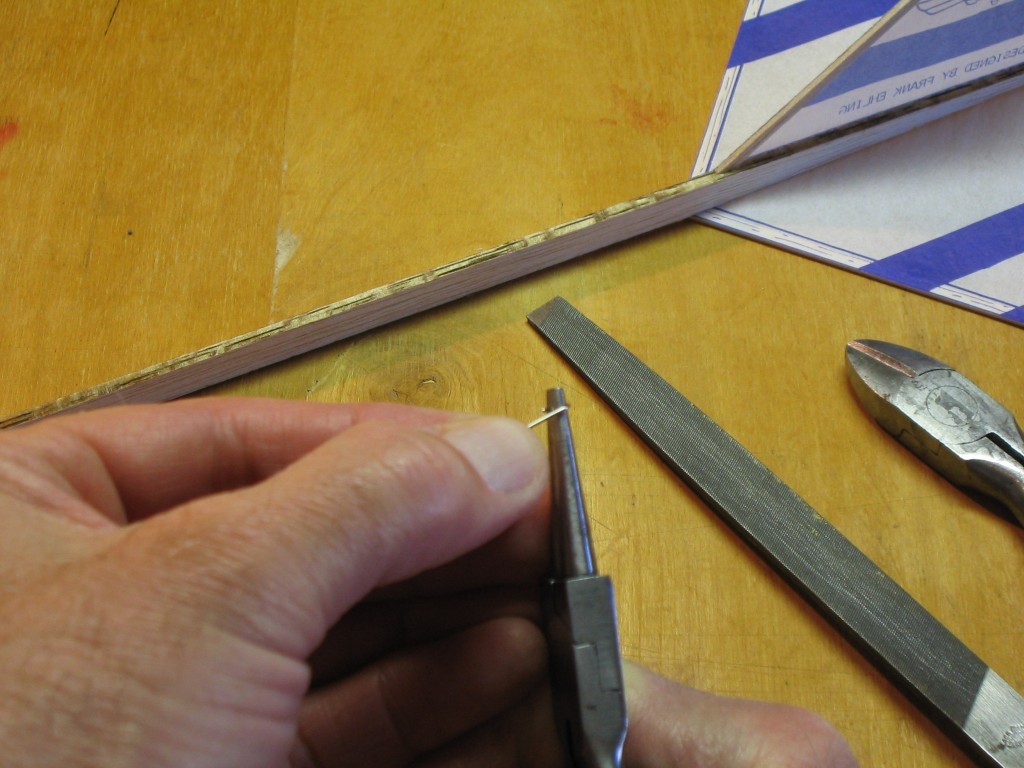



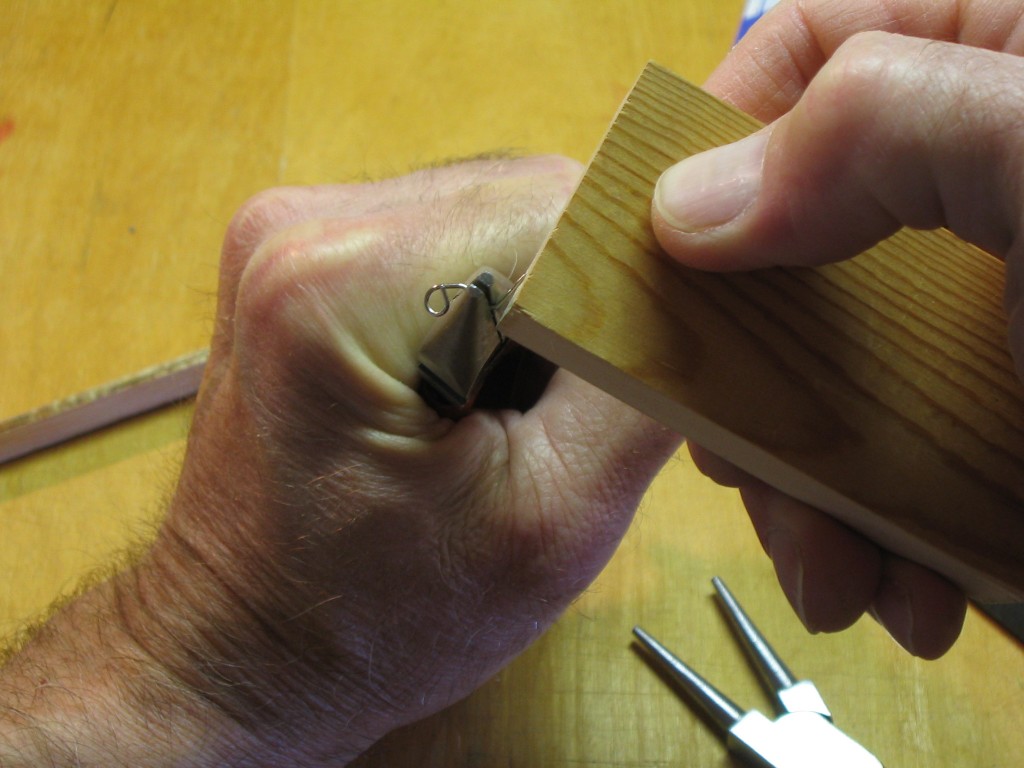







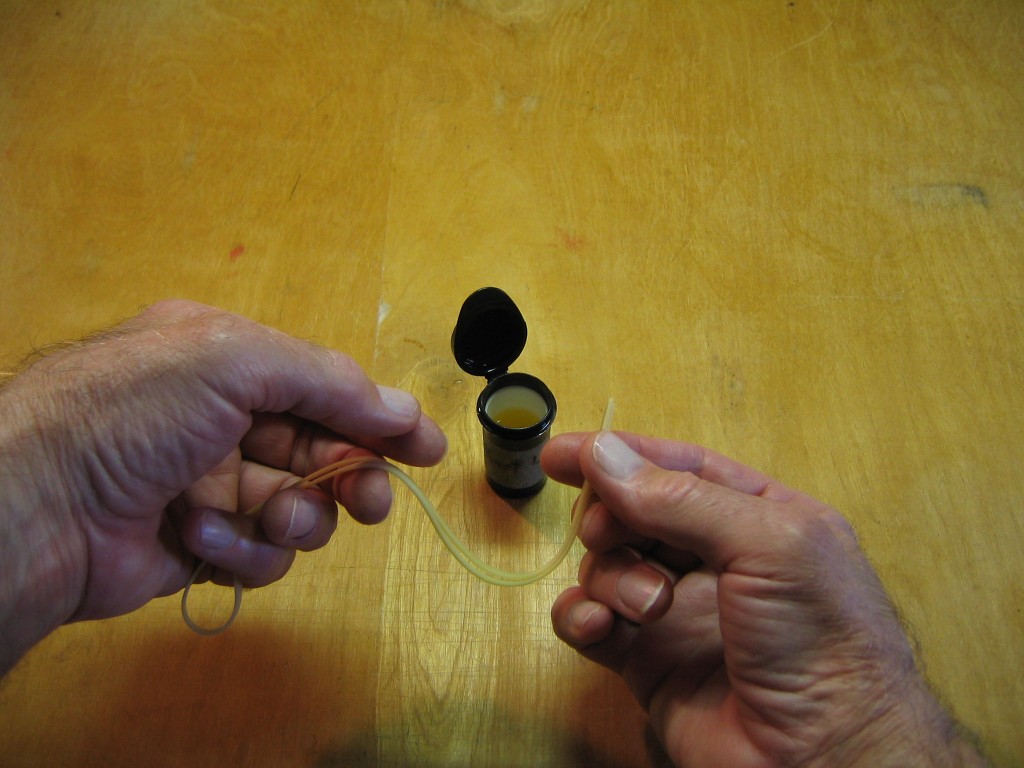






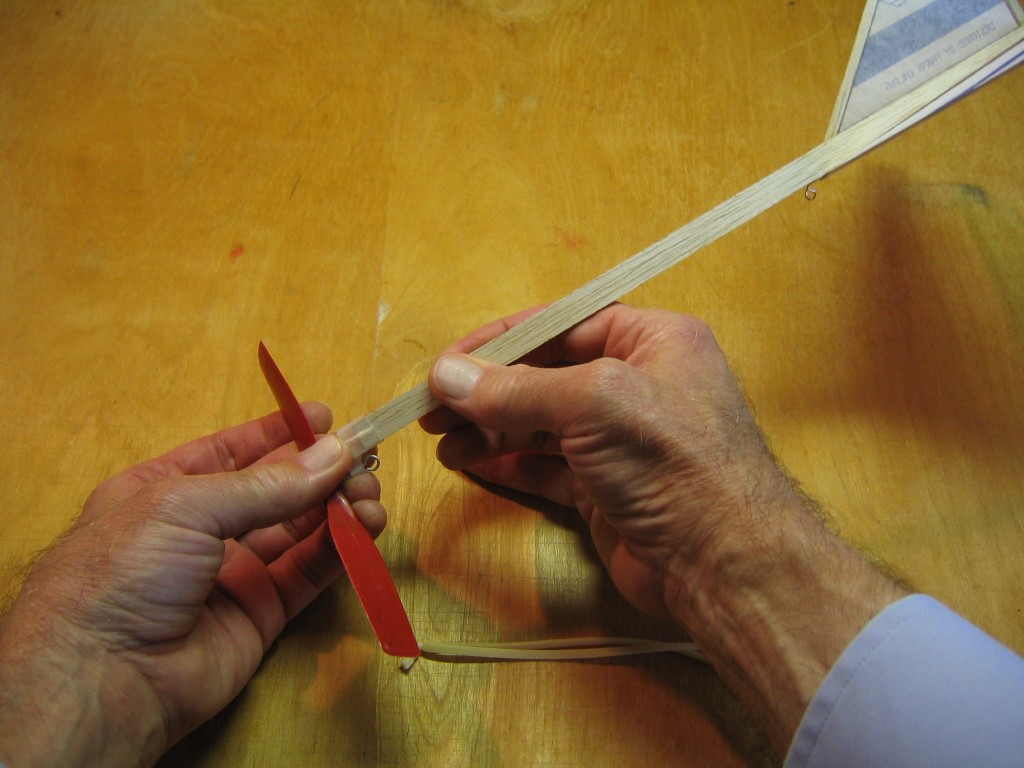



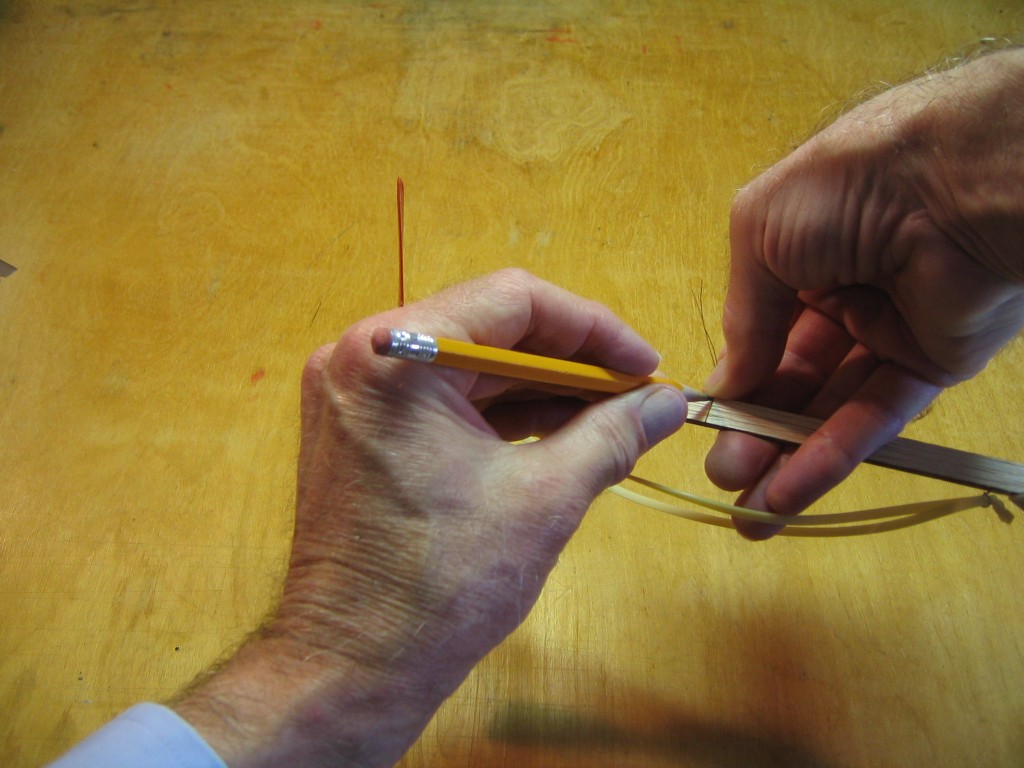







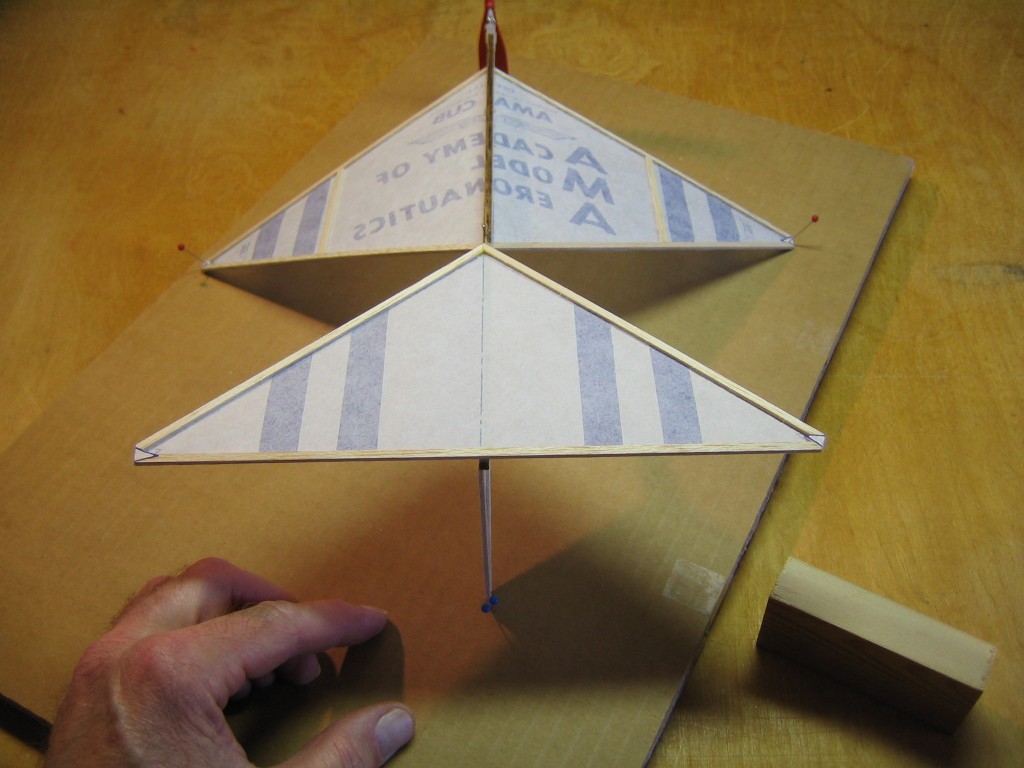
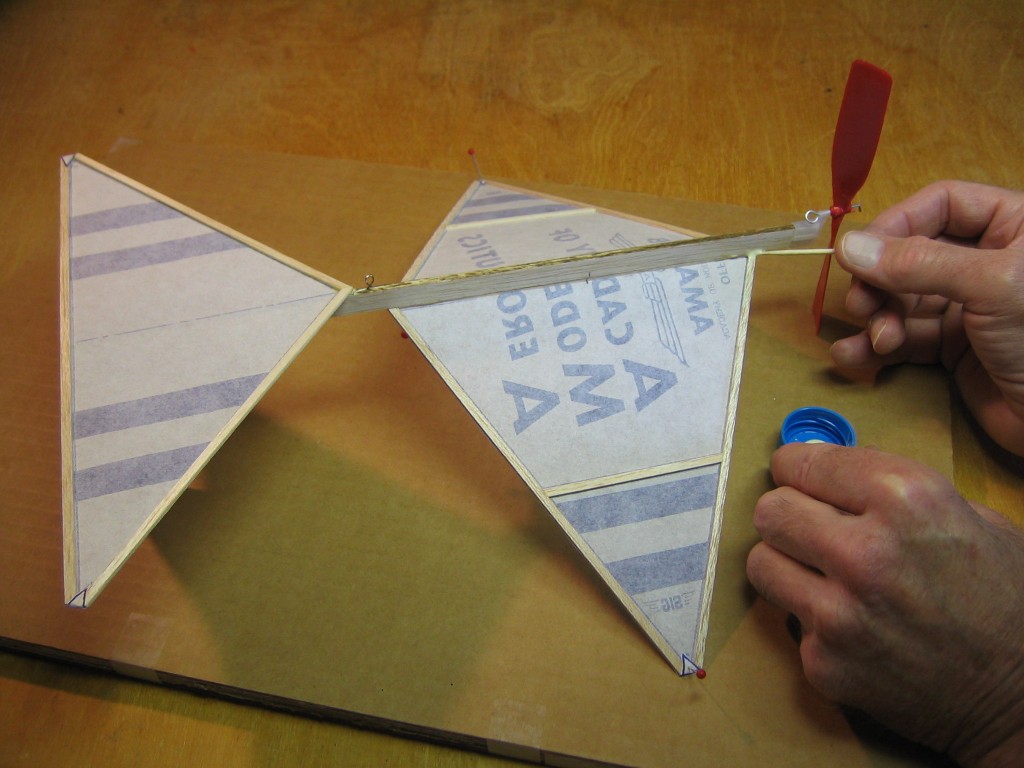
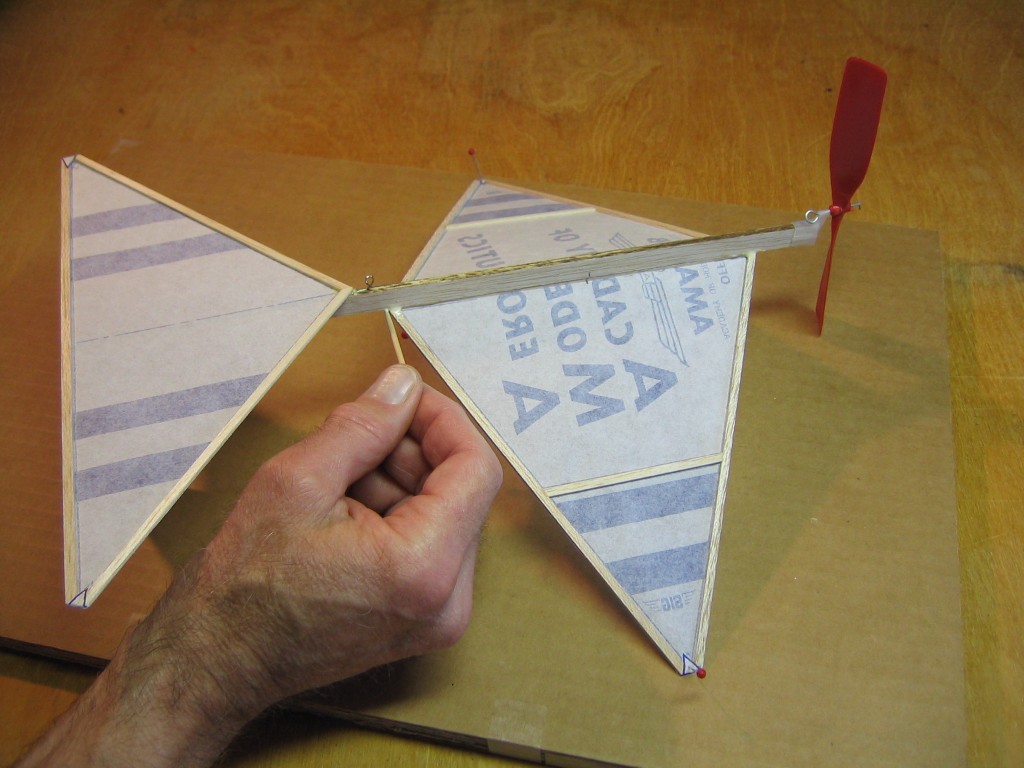










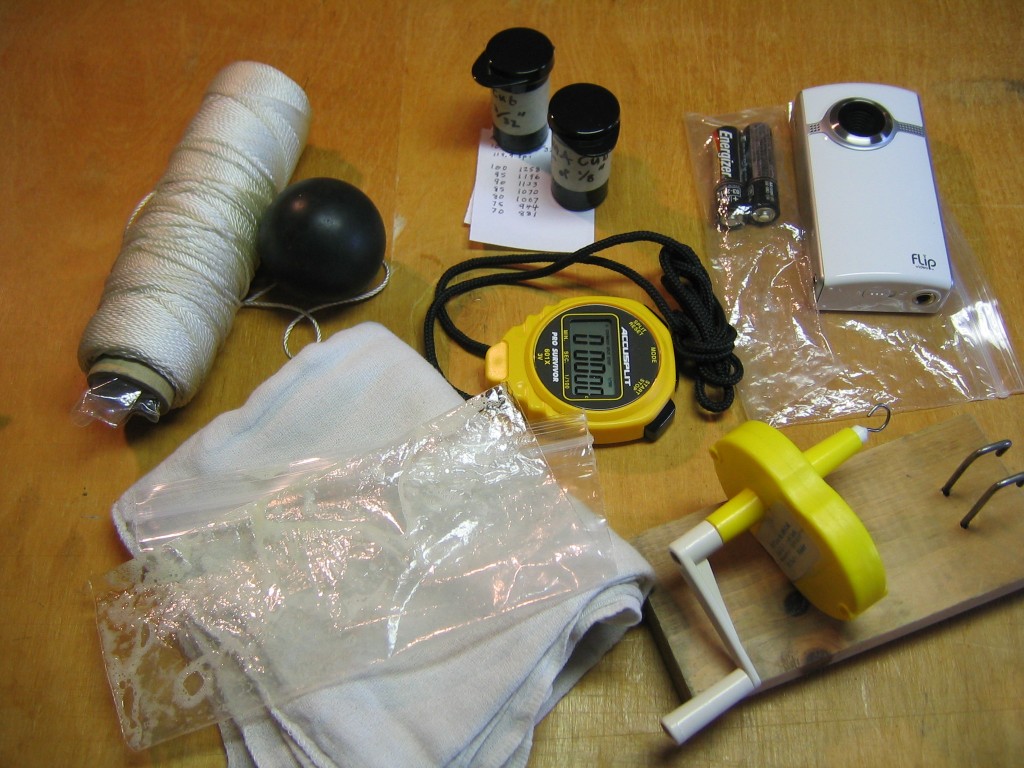








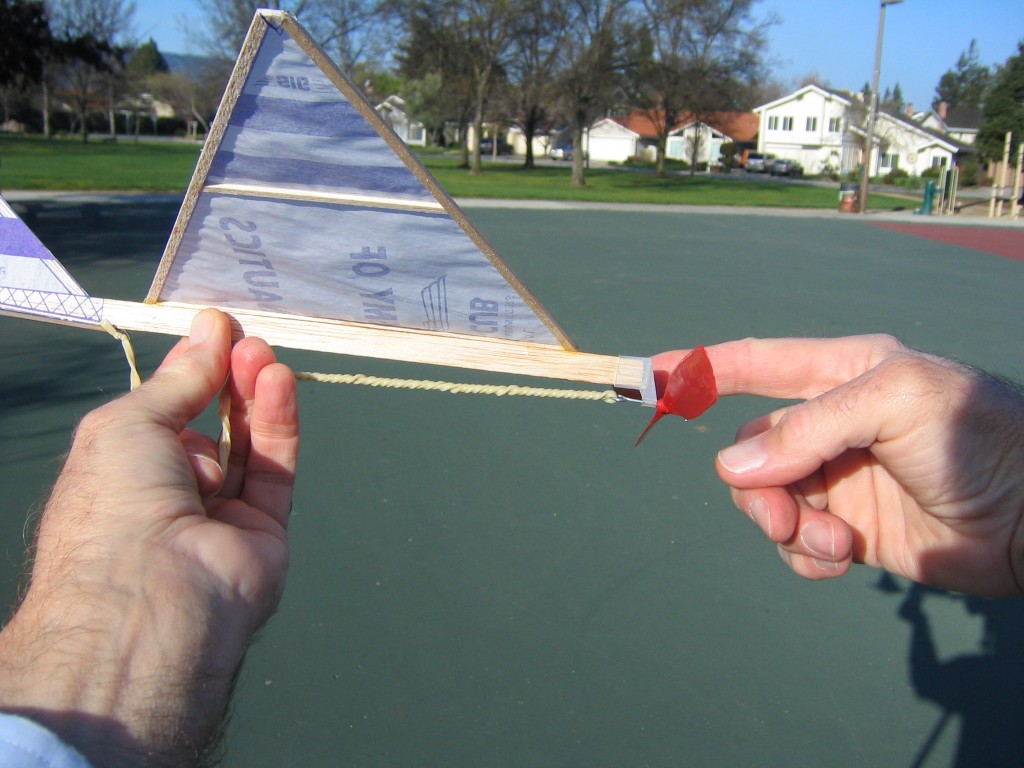










I appreciate this article, especially the part about positioning the wing based on the C.G. and the nifty winding stooge idea. I had my wing all the way forward per the plans, but didn’t think that was going to work out well. I’m glad I found this article.
Hi,
is there any difference between liquid soap and liquid hand wash?
why it should be green?what about other colors?
thanks
Soaps are commonly made from animal fat and lye. Green soaps are made from plant oils and lye, thus the ‘green’. They are not called that because they are green in color. Green soap was used because they are also soft or even liquid, where animal fat soaps are often solid. Glycerin is a moisturizer. It helps keep the soap from drying out and flaking off. There is a recipe for making lube from Ivory soap and glycerin. Ivory soap alone will dry out and flake off. I have used Johnson baby shampoo and liquid dish detergents, like Joy. Try your liquid soap. Does it lubricate your motor? If it dries out, add glycerin. Honey and concentrated sugar solution are also moisturizers, but they get sticky and attract ants. Many modelers these days are using silicon oils and greases for lubricating their motors. I avoid those, especially with kids, because I don’t know the medical consequences of them being absorbed through the skin. There may be other materials that work. Don’t be afraid to experiment. Does it lubricate? Does it not dry out? Does it harm the rubber? Is it safe?
Thanks
Have you ever experienced dashboard polishing for rubber lubrication?
No. Never heard of it being used. If it looks plausible, the best thing would be for you to try it yourself. The main considerations are; it lubricates, it doesn’t dry out, it doesn’t damage the rubber and it is safe. Check the hazardous material data sheet for the last.
Hello
I want to know why tilting stab cause a turn?
I know if left tip of stab be higher than right tip(from rear view), the plane will turn to left and vice versa….but why?
thanks for response …
In the usual trim condition, the wing and the tailplane both produce lift. Look at the plane from the back and imagine an arrow pointing in the direction of that lift. It will be perpendicular to the tailplane. If you tilt the tailplane to one side, that lift arrow will be tilted to one side. That tilted lift will pull the tail to that side, producing a turn.
The AMA Cub has a very short distance between the wing and the tailplane. That means there is a lot of downwash from the wing to the tailplane. Also, the AMA Cub tailplane has a lot of negative incidence. These two things together can produce a situation in which there is negative lift on the tailplane. In that case, tilting the wing will produce a turn in the opposite direction.
Motor torque will roll the plane to the left, producing a left turn. In the absence of torque, the tailplane may be used to set the size of the turning circle. Thus the tailplane is usually used to control the turn in unpowered descent.
Thanks
But direction of turn is my problem yet. In most cases tailplane lift is downward.OK? from rear view if left stab tip be some higher than right, tail lift will be tilted to down and some left.Left component of tailplane lift will force tail to left.True? In conventional airplanes the tail is after the C.G. so in this case the total plane should rotate around CG to right and should produce right turn.but in real world air plane turn in opposite direction that I think.
I can’t understand why and what is my mistake…
(excuse me for my bad English)
Initially the motor torque will overpower the tailplane tilt and bank the plane left so it will fly in a left turn. After the motor runs down, the tailplane tilt will dominate. If the tailplane lift is down and the left tip is higher than the right tip, the lift force will pull the tail to the left, causing a right turn. If the tailplane lift is up, it will pull the tail right and produce a left turn. Also, the freewheeling propeller can produce a turning moment, depending on the angle between the prop shaft and the direction of flight. Other things may also affect turn; sidethrust under power, rudder, wing warps, side offset CG.
OK,thanks
how can we determine direction of tail lift? upward or downward?
which condition is usual for free flight and RC airplanes?
Typically models are trimmed to carry some load on the tail. You can see this when the plan shows that the center of gravity is pretty far back. In that case, raising the left tip will produce a left turn. I found the opposite with the AMA Cub, so concluded the tail was pulling down.
Models can be trimmed to fly with positive, zero or negative lift on the tail. Martin Simons discusses these three trim conditions in “Chapter 12, Trim and Stability” of Model Aircraft Aerodynamics Fourth edition.
Thanks a lot Gary,
very very useful and enjoyable…
I learned so much…
Best Regards,
Davoud
Gary,
The AMA Cub/ Delta Dart was a design that tried to minimize common issues that kids were experiencing 4 decades ago. At that time, tissue covering was the only “skin” covering used on “built-up” models and tricky for novice kids and sort-of experienced parents. The triangular shape was thought to be a simple solution to warping but the “onion-skin” paper still had a propensity to twist up after a day in humidity. The truly excessive dihedral was always a bug-a-boo as was the over sized empennage. Note that all the comments above were made by Frank Garcher formally of Midwest Products whose company was one of three producing the AMA Cub. Walt Van Gorder in Ohio actually kitted an indoor version with great results.
If the airplane has some simple mods, it’s performance sees a dramatic improvement. These include…
1) Reducing the area of the empennage by 30% (or more)
2) Shaving the prop (lighter weight, easier to re-pitch)
3) Mounting the wing according to the CG (1/3 back from the leading edge). Check CG when everything but the wing is on-board.e
4) Drop the wing dihedral by 50%. An upright airplane wing fixture works best during a build session with multiple airplanes. MIDWEST PRODUCTS actually produced a fixture to achieve a lower dihedral with excellent results. It was Part # P-594
5) Add a gusset to all the wood junctures.
6) Cover the wing with tissue (always a great improvement in wing area vs weight)
Best Regards,
Tom Sanders
Great job, Gary. I hope you can do another one with Manuel’s SRPSM (simple Rubber Powered Stick Model).
Ding